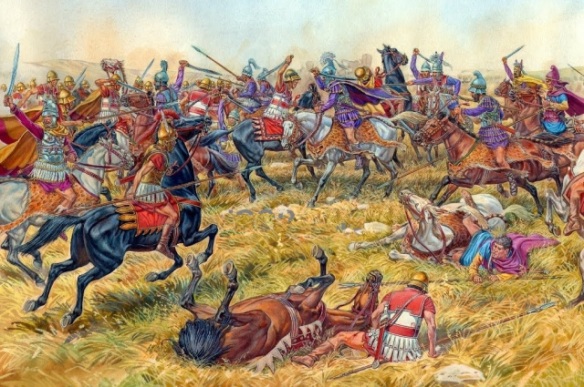Demetrius’ Agema fighting Ptolemy’s Companions at Gaza, 312 BC IGOR DZIS BATTLE PAINTING
The months of the winter of 313/312 brought respite for Cassander, but his situation was still desperate. For the first time since the Lamian War in 322, little of southern Greece, with the notable exception of Athens, was under Macedonian control, and Antigonus’s assurances of freedom had revived a militant spirit of independence among the Greek cities. It would take a miracle to stop Antigonus. The most obvious move would be for him to come at Macedon via Thrace while Polemaeus marched north from central Greece, and that was surely what Antigonus had in mind for 312. But nothing is certain in war.
First, the Antigonid impetus was blunted by internal squabbling. Polemaeus had succeeded in Euboea, where Telesphorus had failed. Not unnaturally, Antigonus gave Polemaeus overall responsibility for Greece. But Telesphorus, in the Peloponnese, took himself off in a huff at this, and created a separate enclave for himself in Elis. His behavior there, such as robbing sacred sites to pay his mercenaries, was winning the Antigonid cause no friends, and demanded attention. Polemaeus soon brought his brother (or cousin) back into their uncle’s (or father’s) fold, but in the meantime he was not available to support Antigonus’s invasion. Fortunately for Antigonus, neither Polyperchon nor Cratesipolis seems to have been in a position to exploit the situation further; they rarely had the manpower for more than defensive work.
Ptolemy proved to be Cassander’s second savior. He had been distracted in 313 and for the first part of 312. He had had to quell a rebellion by the cities of Cyrenaica, and he finally secured the last cities in Cyprus that held out against him. The only anti-Antigonid action he and Seleucus took was to raid Cilicia on their way back from Cyprus; Demetrius rushed to the rescue from Syria, but arrived too late. But by the autumn of 312 Ptolemy’s preparations were ready, and he launched a massive invasion of Palestine by land and sea. His purpose was to recover Palestine and Phoenicia for himself, and to ease the restoration of Seleucus to Babylon.
It was late in the autumn, and if Demetrius had known about the buildup of enemy forces at Pelusium, he had assumed that nothing would happen until the following spring. After his Cilician expedition, he had dismissed his men to winter quarters, and he now had to reassemble them to meet the invasion. As Ptolemy and Seleucus advanced north from Egypt, they were intercepted by Demetrius at Gaza. The town bore twenty-year-old scars from the time when Alexander had razed it to the ground and massacred its inhabitants, but it was still the final destination of major caravan routes from the east, and spices left its harbor for destinations all over the Mediterranean. Antigonus had left Demetrius with a cluster of senior advisers, who urged caution, but Demetrius was young and hot-headed, with extraordinary good looks and charm that led him to believe that he could get away with anything. He imagined, perhaps, the fame that would accrue to him if he defeated two of Alexander the Great’s generals. The armies deployed for battle on the plain south of the town.
In the center, where the infantry phalanxes were deployed as usual, Demetrius was outnumbered. This did not overly concern him, however, since he planned for his cavalry to sweep all before them. He massively bulked up the cavalry contingent on his left wing; the right wing was correspondingly weaker, but if things went well, it would not be used at all. Given its weakness, he had it “refuse”—deploy at an angle back from the main line of battle—so that it would be harder to outflank. He posted his elephants along the whole front of the line at its weak points. Ptolemy and Seleucus had also bulked up their left wing, so when their scouts brought back information about Demetrius’s disposition, they had to make some hasty adjustments. They had no elephants themselves, but they knew how to deal with Demetrius’s beasts: they sowed spiked caltrops, like a minefield, in front of their line, and posted their light-armed troops out in front with plenty of javelins.
The action began, as Demetrius had intended, on his left, Ptolemy’s right. Thanks to Ptolemy’s last-minute adjustments, the two wings were closely matched in numbers and commitment, and the overwhelming charge that Demetrius had hoped for became bogged down in a fierce and close-fought struggle. In the center, his elephants were foiled by the caltrops and became vulnerable to the skill of Ptolemy’s skirmishers. Most of the mahouts were shot down, and the elephants were captured. When Demetrius’s cavalry realized that their infantry phalanx was now vulnerable to Ptolemy’s superior numbers, many of them turned to flight. Demetrius, left almost isolated, had no choice but to break off as well. A retreating army was vulnerable to massacre, but they kept due order and made it safely back to Gaza. At that point, discipline broke down as the men poured into the city to rescue their baggage, and when Ptolemy’s troops came up they were able to take possession of the city. Demetrius fled by night farther north, abandoning Palestine to Ptolemy.
It was the decisive battle of the war. Demetrius lost only a few hundred, mainly cavalrymen, on the field of battle, but almost all his foot soldiers surrendered and were incorporated by Ptolemy into his own forces. The loss of the entire Syrian army in the east was bound to draw Antigonus from Asia Minor. He had taken up winter quarters in Phrygia, but it was clear that, as soon as he could, he would march south, back across the Taurus Mountains—to see, it was said, how Ptolemy would fare against an adult adversary, rather than a beardless youth. The invasion of Greece was postponed indefinitely. The miracle for which Cassander had been praying had taken place.
